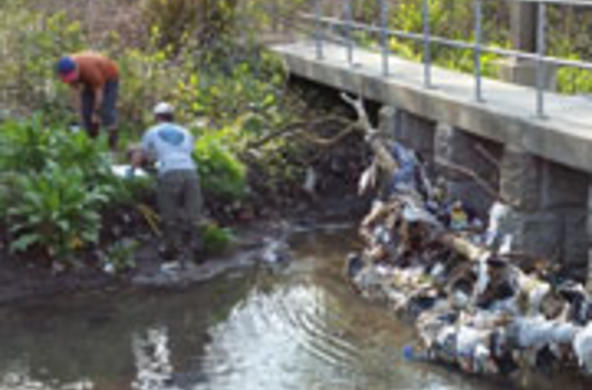What do stock market crashes, epileptic seizures, and ecological breakdowns have in common? They are all preceded by an increase in variance—be it fluctuations in the Dow Jones index, brain waves, or, in the case of a Wisconsin lake, chlorophyll.
Cary Institute limnologist Jonathan Cole was part of a research team that was the first to reveal how variability in key ecosystem processes can help scientists identify the early warning signs of ecosystem collapse. Their paper was published in the journal Science.
"Early warning signs help you prepare for, and hopefully prevent, the worst case scenario," notes Cole. "We are surrounded by problems caused by ecological regime shifts—from water supply shortages to fishery declines; our study shows that we can identify these changes before they reach their tipping point."
In a large field experiment, the team triggered a regime shift in a freshwater lake by introducing bass. The study lake was originally dominated by small fish that feed on tiny free-swimming invertebrates. Their goal was to destabilize the lake and observe the changes that led to a food web dominated by predatory fish.
As bass numbers increased, smaller fish spent more time swimming in groups near the shoreline to avoid being eaten. Freed from predation, open water invertebrates shifted to forms that were larger in size. Phytoplankton, the tiny plants that are a dietary staple of these invertebrates, became more variable.
Within three years, the lake's food web had completely shifted to one dominated by large fish-eating fish and larger free-swimming invertebrates.
Throughout the lake's manipulation, a buoy was used to record chemical, biological, and physical vital signs, noting even the smallest changes. Manual samples were also taken daily. By analyzing these massive sets of data, the team was able to detect that an ecosystem shift was looming.
More than a year before the food web transition was complete, variance in chlorophyll—the green pigment found in plants and algae—was a reliable indicator of the impending food web shift. The study is the first time that an early warning sign for ecosystem collapse has been validated in the field. If similar signs could be identified in other types of ecosystems, it would revolutionize environmental management, according to the study's authors.
The catch? Early warning sign identification requires extensive insight into an ecosystem's unique chemical, physical, and biological properties. The chlorophyll "red flag" would only help identify food web shifts in freshwater lakes. Such an approach may not be practical for every ecosystem, but once initiated regime shifts can be difficult to reverse. When water is no longer potable or fisheries lose productivity, the economic and ecological costs can be staggering.
The paper highlights the importance of long-term environmental monitoring efforts. Without them, environmental regime change predictions are impossible. Cole notes, "Automated sensors, remote sensing technology, and computing are making continuous environmental monitoring much more accessible." Looking toward the future, the marriage between monitoring efforts and predictive statistics will be a valuable tool in managing resources in a changing world.






